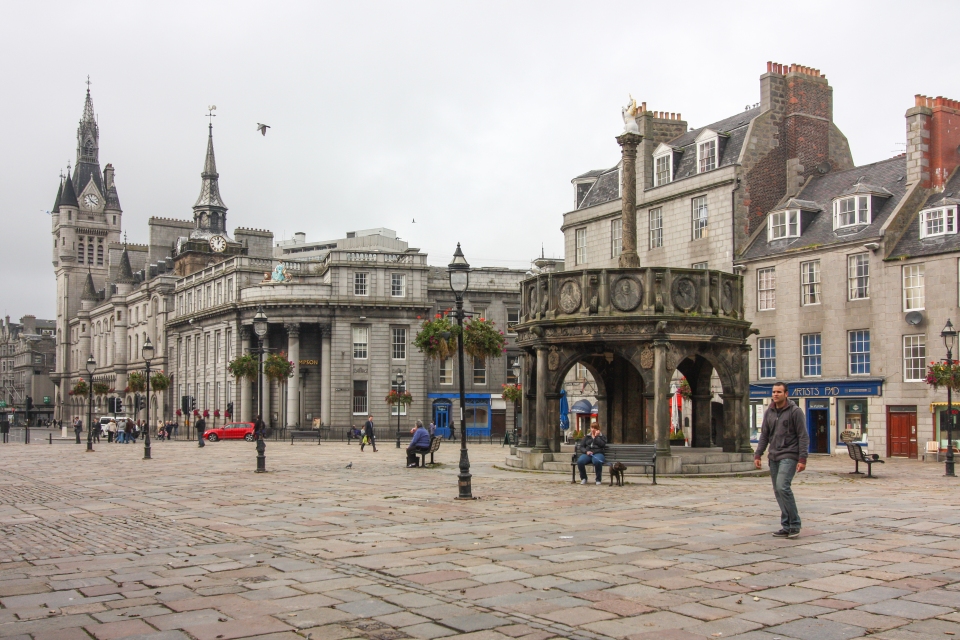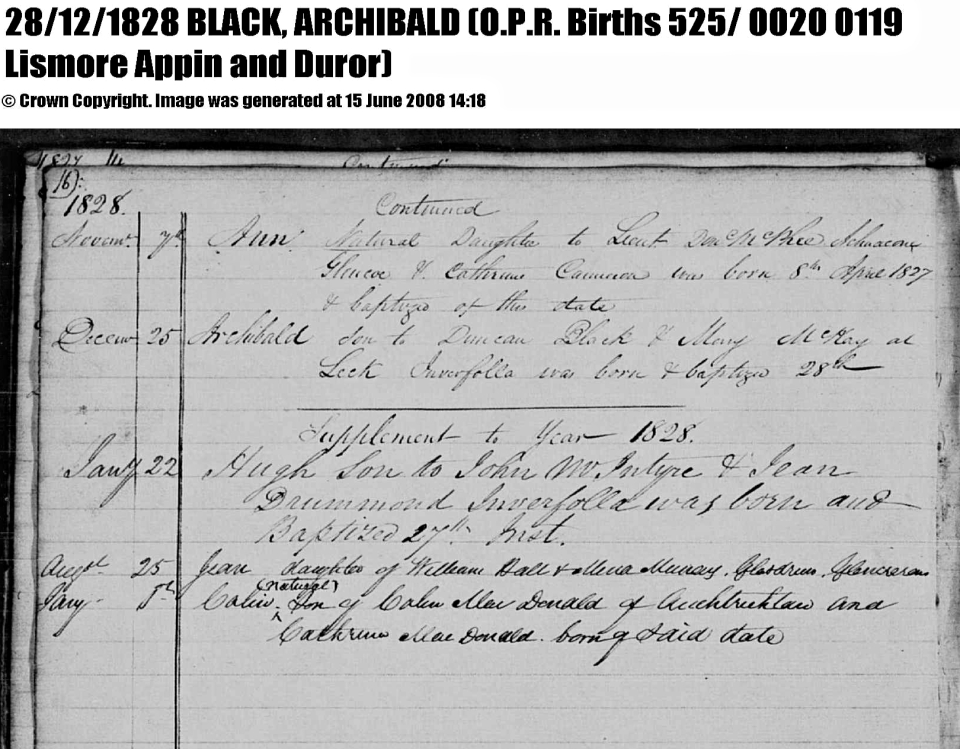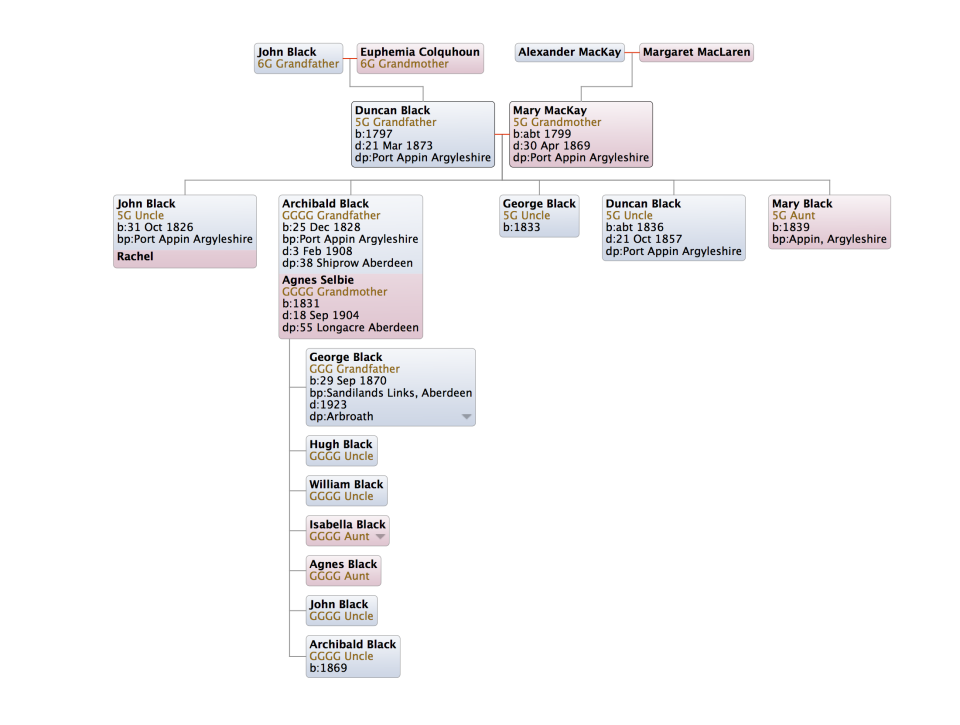In my previous post, I thought I had fully described the seven children who made up the family of Archibald and Agnes in Aberdeen. But, checking through all sources, I discovered that there were in fact eleven children born to them. Sadly only six survived to adulthood.
- Mary McKay Black was the first born child, named for her paternal grandmother, born 3rd May 1855 and died 2 June 1857 in Aberdeen, aged 2. The family were then living at 11 Yeats Lane, Aberdeen. Mary had had chronic hydrocephalus for 12 months – this was given as the cause of death. She was buried in Spital (St Peter’s) Cemetery, Aberdeen.
- Hugh McColl Black was born 8th October 1857 and died at the age of 72, in May 1930. (I haven’t yet discovered where the name McColl came from.) He was working as a plant attendant at a chemical works and living at Woodside, Aberdeen. He married Matilda McIntosh and had a family of eight children: Isabella, Annie, Hugh, Agnes, Georgina, Matilda, Fanny and Arthur. Arthur was the informant for his death certificate. His wife Matilda outlived him by 24 years, dying in 1954 at the age of 95. Hugh was buried in St Peter’s Cemetery on 17 May 1930. HIs daughter Georgina migrated to Canada and was married in Vancouver in 1920, to William Lamont, also from Aberdeen.
- William Selbie Black, born 14 February 1859 lived to the age of 66, dying on 25 December 1925. He also worked at the chemical works and it was there that he died, on the job. His marriage to Margaret Grassick led to the birth of ten children, eight of whom survived to adulthood: Hugh, Frederick, William, Margaret, Alexander, Mary, Archibald, and Duncan.
- Isabella Black was born on 24th October 1861. She married David Malcolm in August 1881 and had five children: Agnes, David, Robert, Archibald; the youngest child, Isabella, died at two years of age in 1906. Isabella died in Aberdeen on 12 February 1917.
- Duncan Black was born in November 1863 but died on 31st July 1868, aged 4, from “hooping cough 12 weeks, bronchitis 10 days“. The family were living at Sandilands Links at the time. He was buried on 3rd August in St Peter’s Cemetery, Aberdeen.
- Agnes Black was born in 1866. She died at the age of 21 on 5 July 1887, of typhoid fever. She was buried on 7th July in St Peter’s Cemetery, Aberdeen.
- Margaret Black was born on 18 July 1867, but died at eleven months of age on 17 June 1868. She had had “hooping cough” for three weeks. She was buried on 19 June in St Peter’s Cemetery, Aberdeen.
- Archibald Black was born 27 January 1869, but died at two years age on 5th June 1871. The cause of death was “hemiplegia 5 weeks, convulsions 3 days“. He was also buried in St Peter’s Cemetery on 7th June.
- George Black (Liam’s ancestor) was born 29 September 1870, fathered eight children and died in Arbroath in 1923, aged 52. George also worked at the chemical works. More on him in a further post.
- A second child named Archibald Black was born on September 1st, 1872, one year after the death of the first Archibald, but he too did not survive, dying on 3rd July 1873, at ten months of age. His cause of death was phthisis (a previous term for tuberculosis) of three months duration. At the time the family were living at Sandilands Links, Aberdeen. He lies with his siblings at St Peter’s Cemetery, buried on 5th July.
- The youngest child, John Black, was born in 1875, and died in 1938 aged 63. He also worked at the chemical works. He married twice, first to Alice Jane Davidson in 1893. They had four children: Jessie Ross, Rachel Crighton, John, and Frederick Davidson Black. Alice died on 20th June 1900 in the Royal Infirmary, Aberdeen, from phthisis pulmonalis (tuberculosis) aged 27. John married Elizabeth or Lizzie Sinclair in March 1901. Lizzie came from Wick in Caithness and had a son from her first marriage, James Houston. Lizzie died before John, in 1935. John and Lizzie appear to have had no children together.
My source for this information is principally Scotlands People for birth, death, marriage and census records. However I am also indebted to a user on Family Search who has added a Black genealogy which has helped to point the way towards some of the children of Archibald and Agnes and other generations of Blacks. The family tree for Archibald and Agnes is shown in the attachment (click to open in new window).










